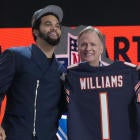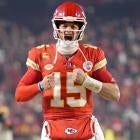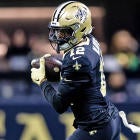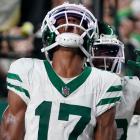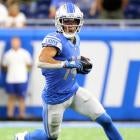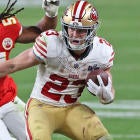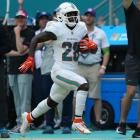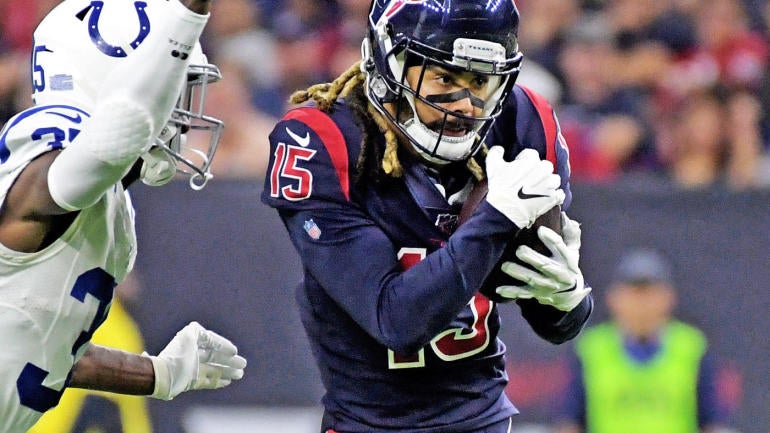
I took something of a Zero-RB approach in our latest Fantasy football mock draft, a full-PPR league with three starting wide receivers and a flex spot. And as it turned out, there were some big questions about specific picks I made. Was it early to grab Mark Andrews in the third round? Will Fuller in the fifth? And how crazy am I to have J.K. Dobbins as a starting running back?
Those questions have been raised on the Fantasy Football Today podcast and Fantasy Football Today show on CBS Sports HQ throughout the week, and yet, the team is one of my favorites I've constructed in 2020. Because these are common questions many people might have about this approach, it is useful to dive more into how and why I made these decisions, and why I wish this was a league we were playing out during the season.
First, here's the team I came up with:
- 1.10: Davante Adams, WR, Packers
- 2.03: Tyreek Hill, WR, Chiefs
- 3.10: Mark Andrews, TE, Ravens
- 4.03: A.J. Brown, WR, Titans
- 5.10: Will Fuller, WR, Texans
- 6.03: D'Andre Swift, RB, Lions
- 7.10: J.K. Dobbins, RB, Ravens
- 8.03: Christian Kirk, WR, Cardinals
- 9.10: Boston Scott, RB, Eagles
- 10.03: Tevin Coleman, RB, 49ers
- 11.10: DeAndre Washington, RB, Chiefs
- 12.03: Darrynton Evans, RB, Titans
- 13.10: Jared Goff, QB, Rams
- 14.03: T.J. Hockenson, TE, Lions
- 15.10: Bears DST
- 16.03: Greg Zuerlein, K, Cowboys
The start to this team is pretty unassailable, particularly if you're looking at my rankings. I actually have Hill over Adams for this season, as his 2019 was a bit underrated given he left two games early and missed four others. He otherwise paced for a line close to his 2018 season, and I think his offensive situation screams upside whereas Adams is locked into a massive target share but there are at least some concerns about how run-heavy the Packers might want to be.
Still, that's a minor quibble, and I have this duo in their own tier behind only Michael Thomas. I took Adams first expecting Hill to be more likely to swing around the turn, and nabbing two of my top-three wide receivers is a fantastic start in theory. Was it in practice?
The questions start immediately after — does this WR-WR start cost you at RB, and is that really worth it? How do you construct a winning team in RB-heavy 2020 drafts with this two-round start?
Winning everywhere but RB
The answers to the questions about the Andrews and Fuller picks are purely related to the strategy I was employing. By the time I was up at 3.10, there was virtually no chance I'd draft a running back. That's because from the late third round through about Round 7, the Running Back Dead Zone exists, an area of drafts where running back picks are far less likely to help you win your league than moves at other positions. Whether you see that part of drafts as evidence you need to lock in a RB in the first two rounds, as many do, it is still something you have to be cognizant of if you do go WR-WR or another non-RB start like WR-TE.
In other words, by the time the 3.10 rolled around, I knew I was going to be doing some form of Zero RB. If I hadn't started with two elite wide receivers, that third-round pick would have been a perfect spot to grab my second wide receiver. But because I knew I was already ahead at WR and had plenty of time to finish out a great receiving corps, I made it a priority to select my next-best tight end available to lock in what I think will be high-end production at that roster spot.
Then, I grabbed A.J. Brown, an asymmetrical upside bet that couldn't be a better fit as a WR3 where his inevitable down games when Tennessee goes massively run-heavy won't hurt as much. That logic extended to Fuller, and by the end of Round 5, my Flex position was accounted for with another player I think could finish in the top 20 of overall players. Fuller is a fantastic talent, has an elite connection with Deshaun Watson that Brandin Cooks and Randall Cobb don't, and is more than just a deep threat — he's poised to be a smash pick in Round 6 or Round 7 but still carries plenty of upside into Round 5, especially for a team build like this one.
It's important to emphasize how I leaned into this team-building strategy. Many people who try Zero RB or similar strategies where they don't go as heavy on running backs early only dip their feet into the water. With this team build, I am diving head first into volatility and upside to build a lineup that I want to be able to crush my weekly opponents at all four wide receiver spots (including the Flex) plus tight end. No legitimate proponent of Zero RB is saying that the RB position doesn't matter to Fantasy. To justify intentionally ignoring such a potentially high-scoring position, your weekly advantage at the other lineup positions better be huge.
Of course, the reason you would do this remains that running backs are fragile and bust at a high rate. But of the 11 other likely RB-heavy drafters in your league, someone is going to get good injury luck at RB. To execute Zero RB in a way where you can beat whoever comes out of their RB-heavy roster build with strong RB production, you need to be able to gain a ton of ground on what will be weaker wide receivers and tight ends.
You don't have to fill out your starting lineup first
That said, I arguably pulled out of my Zero RB dive early by grabbing D'Andre Swift immediately following my first five picks in the early sixth round. Swift's value is rising with talk of his passing downs role and a 50/50 split, giving him a solid early-season projection as a weekly starter in PPR leagues plus huge upside if Kerryon Johnson continues struggling to stay on the field. The latest expectations of his role are confirmation his Fantasy profile is very similar to Kareem Hunt's.
But the next turn is the most interesting part of this draft, in my opinion. At the end of Round 7 and the beginning of Round 8, despite a roster already filled through the Flex at wide receiver and without an RB2, I took two bench players. First, I grabbed a sliding J.K. Dobbins, whose Week 1 role is very unclear but who continues to turn heads in camp. When I made this selection, it was purely an upside decision and I had no plan to start Dobbins Week 1. There are plenty of running backs through at least Round 12 in any 2020 draft that we can trust to have a Week 1 role.
But with this roster, I need a running back group that has massive upside. If one of Swift or Dobbins spends time in 2020 as the lead back for their respective offenses, they will likely be viewed as a top-15 back for however long they are in that role. With the wide receiver and tight end production this roster has, any week with that type of RB1 upside makes this a nearly unbeatable team. Do I expect Dobbins to beat his draft position with his full-season production? No, not really. But he's a great start to a backfield where I hope to get multiple high-end starting weeks throughout the season. It's a patchwork strategy, not a clear plan.
Then I drafted Christian Kirk. For those Zero RB drafters I referenced above who dip their toes in, this might be viewed as a major mistake, the point at which the strategy jumped the shark. I would argue it was a crucial pick to the strategy as a whole — even with the top five picks I made, I can't be certain I'll get elite production from each of them for 16 weeks without injury or bust potential. But my running backs are already going to be on the weaker end; this strategy requires me to win those other positions. Thus, Kirk — who I love as an upside play in all formats — gives me at the least a strong bye week fill-in to ensure high-end Flex production, and if he breaks out in a way, say, Fuller doesn't, he might become a weekly starter.
Rather than pivoting to a high-floor running back I could "trust" (and I put that in quotes, because trusting any RB workload is probably a mistake), the Dobbins and Kirk picks were me pressing an advantage. Zero RB is a strategy, after all, and if you're going that direction, you need to understand what makes that strategy work.
This is a concept original Zero RB author Shawn Siegele recently discussed while reviewing a draft I was lucky enough to co-manage with him, in a piece aptly titled, "Struggling with Zero RB? You're probably not drafting enough WRs". There's a good case made within that this mock draft roster I built is still a receiver short, even with Kirk. But this draft was a shallower league format, so that's a trade off I had to make.
Over the next four rounds, I hammered the running back position. One of Boston Scott and Tevin Coleman, who I took in Rounds 9 and 10, will start Week 1 alongside Swift. DeAndre Washington and Darrynton Evans are both falling a bit due to early camp reports that they aren't as involved in their offenses as expected, but both retain major upside and make for strong RB5 and RB6 picks. A few weeks ago, I named Scott and Evans my favorite RB sleepers.
Jared Goff is one of my favorite late-round quarterbacks this year, and T.J. Hockenson is my favorite late-round tight end. If Hockenson breaks out, I also have resiliency at tight end should Andrews falter. The end result is a roster I feel very confident will gain ground weekly at five key starting lineup spots — the three WR spots, TE, and Flex. This is an absolute necessity of the Zero RB strategy, and pulling out of your dive into this strategy without ensuring you have a roster strong enough to accomplish that specific reality can leave you both weak at running back but also not strong enough at the other positions to justify that.
Goff will keep this team competitive at QB, and then this RB corps — even though I waited until Round 9 or 10 to take one of my two Week 1 starters — has a strong enough mix of solid PPR potential and high-end upside in any format to make this a roster I doubt would finish any worse than middle of the pack. More practically, I can say I've done this many times, and that I've never executed the Zero RB strategy as well as I felt I did in this draft and not finished at the very least in playoff contention, and that would be an outcome where several things went wrong.
Of course, throughout the season, I would also obviously be scouring the waiver wire from here for more RB reinforcements. And getting anything to stick at that position — whether through the upside depth I drafted, the waiver wire, even trade — would give this roster the type of elite upside that runs away with leagues.
Which players are poised for breakouts, which sleepers do you need to jump on, and which busts should you avoid at all costs in your Fantasy football league? Visit SportsLine now to get early rankings, plus see which WR is going to come out of nowhere to crack the top 10, all from the model that out-performed experts big time last season.














